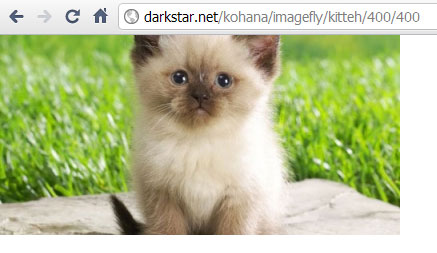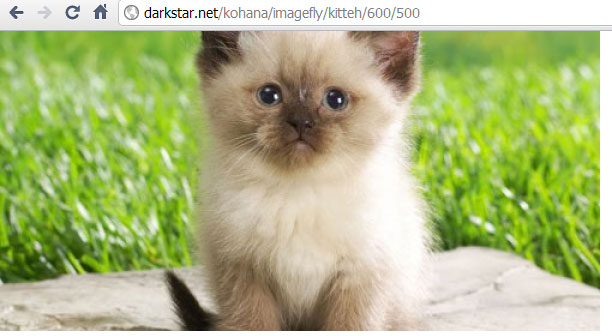In this example, we have images under /uploads under the webroot directory. We allow the user to render any image with dynamic dimension and is resized on the fly. It also caches the response for 1 hour to show basic caching mechanism.
First, we need a Route. This Route is based on this URL pattern:
/imagefly/filename/width/height - where filename is the name of the image without the extension. This assumes that all images are in jpg and all filenames uses numbers, letters, dash and underscores only.
This is our Route definition:
/**
* Set route for image fly
*/
Route::set('imagefly', 'imagefly/<image>/<width>/<height>', ['image' => '[-09a-zA-Z_]+', 'width' => '[0-9]+', 'height' => '[0-9]+'])
->defaults([
'controller' => 'imagefly',
'action' => 'index'
]);
We ensure that the filename is only composed of letters, numbers and underscores, width and height must be numeric.
Our controller simply accepts the request and capture the following parameters as defined by the Route:
filename - without the filename extension (and without dot)widthheightThen it finds the image file and when found, render it on the browser. Additional features added are browser caching.
<?php
class Controller_Imagefly extends Controller
{
public function action_index()
{
$file = $this->request->param('image');
$width = (int) $this->request->param('width');
$height = (int) $this->request->param('height');
$rendered = false;
if ($file AND $width AND $height) {
$filename = DOCROOT . 'uploads/' . $file . '.jpg';
if (is_file($filename)) {
$this->_render_image($filename, $width, $height);
$rendered = true;
}
}
if (!$rendered) {
$this->response->status(404);
}
}
protected function _render_image($filename, $width, $height)
{
// Calculate ETag from original file padded with the dimension specs
$etag_sum = md5(base64_encode(file_get_contents($filename)) . $width . ',' . $height);
// Render as image and cache for 1 hour
$this->response->headers('Content-Type', 'image/jpeg')
->headers('Cache-Control', 'max-age=' . Date::HOUR . ', public, must-revalidate')
->headers('Expires', gmdate('D, d M Y H:i:s', time() + Date::HOUR) . ' GMT')
->headers('Last-Modified', date('r', filemtime($filename)))
->headers('ETag', $etag_sum);
if (
$this->request->headers('if-none-match')
AND (string) $this->request->headers('if-none-match') === $etag_sum
) {
$this->response->status(304)->headers('Content-Length', '0');
} else {
$result = Image::factory($filename)
->resize($width, $height)
->render('jpg');
$this->response->body($result);
}
}
}
When the parameters are invalid or the filename does not exists, it simply returns 404 not found error.
The rendering of image uses some caching mechanism. One by setting the max age and expire headers and second by using etags.
Visiting http://localhost/kohana/imagefly/kitteh/400/400 yields:

Visiting http://localhost/kohana/imagefly/kitteh/600/500 yields:
